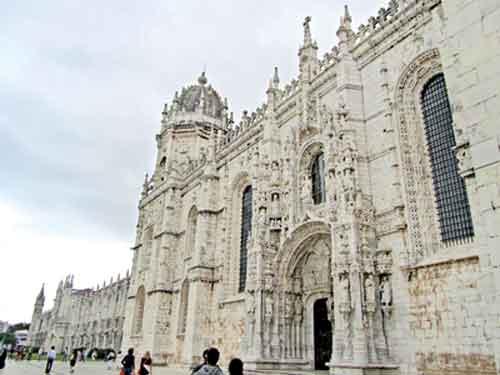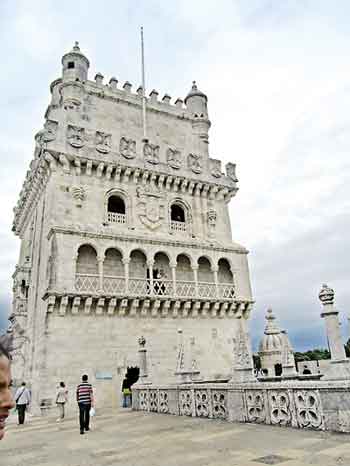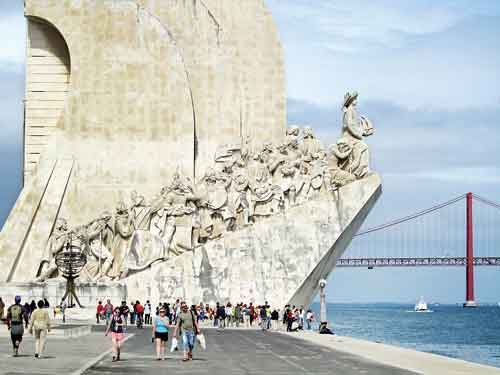Feeling at home in the historic city of Lisbon

Monastery of the Geronimos
I must admit that I as a Sri Lankan felt very much at home when I was visiting Portugal’s capital city of Lisbon.
Maybe it was the familiarity I felt with their language – like going to a shop when we needed ‘bread’ and ‘soap’ and asking for pão (pronounced paang) and sabão (pronounced sabang). After trying on camisas(shirts), calças (trousers) and sapatos (shoes) in one of Lisbon’s department stores, I was left in no doubt as to who introduced shirts, trousers and shoes into our country. Even the utensils in their kitchens –garfo (fork), bandejo (tray), copa (drinking cup), even balde (bucket) and banco (bench) – are known by the very names we have Sinhalised into gaarappuva, bandesaya, koppe, baaldiya and bangkuva and use in our day to day life in 20th century Sri Lanka!
Maybe I felt I was among friends because of the names I came across in shop-fronts and nameplates of houses. They could have come straight out of the Colombo telephone directory! Here were names like Pereira, Gomes, Silva, Alves, Dias, Costa, Saldanha, Salgado, Cabral, Caldera and Rozairo. Even the swarthy facial features, the physiognomy and the easygoing attitude of the locals reminded me so much of folk back home in Sri Lanka.
In Lisbon we ate foods like Queijadas, Chamosas, Risoles and Empadas that looked just like the Cheesecakes, Samosas, Chinese rolls and Patties that I used to enjoy so much as a child. Finally I knew who introduced these “typically Sri Lankan” foods into our country!

Belem Tower
In the early 16th century it was the Portuguese who first left the safety of Europe and ventured east around the southern cape of Africa to discover the world across the seas. In so doing they created what could well be called the first global village.
The city of Lisbon, which has been their capital since the 13th century is a port city situated at the open mouth of the River Tejo. During the Portuguese Age of Discoveries it became one of Europe’s wealthiest cities, built and embellished by the wealth that came from her lucrative colonies in America, Africa and Asia. To the Portuguese speaking world, Lisbon represents what Paris is to the Francophone peoples – their cultural centre and the spiritual home of their Lusitanian soul.
Among the ‘must see’ parts of Lisbon is the old Belem area which has the famous Belem Tower, the fabulous Monastery of the Geronimos and the towering Monument to the Discoveries which was built in 1960 to commemorate the 500th death anniversary of Prince Henry the Navigator. The Geronimos Monastery, funded by a 5% levy on spices brought in from India, stretches about 300 yards along the Belem waterfront. It contains some beautiful cloisters and houses the tomb of Vasco Da Gama.
Also worth seeing when in Lisbon is the Caloust Gulbenkian Museum (http://www.museu.gulbenkian.pt) a fascinating collection lovingly accumulated during his own lifetime by one man, Calouste Gulbenkian. It has a range of exhibits ranging from 5,000- year-old Egyptian carvings in its Oriental and Classical Art section to some beautiful 18th century French works in its European Art section.

Monument to the Discoveries
The highest point of the city is the Sao Jorge castle at the top of the Alfama Hill, originally built in the 11th century by the Moors who ruled this part of the Iberian peninsula at the time. Offering splendid views over the city from its ramparts, it also gives one the opportunity to relax in the palace gardens where peacocks and ducks strut about.
You may be lucky enough to attend one of the live concerts of traditional Fado music often held of an evening in the castle grounds. Fado is Portugal’s traditional form of folk music that combines musical traditions from rural parts of the country with Moorish and Afro-Brazilian influences. The songs – usually nostalgic, often mournful, invariably about homesickness or unrequited love -are performed by a single singer, male or female, traditionally accompanied by an acoustic guitar and the guitarra , the pear-shaped lute with twelve wire strings that is unique to Portugal.
Whether it is Lisbon’s Fado or its food, its music or its monuments, this is a city that has so much for the visitor to savour.
Especially for visitors from
Sri Lanka!


